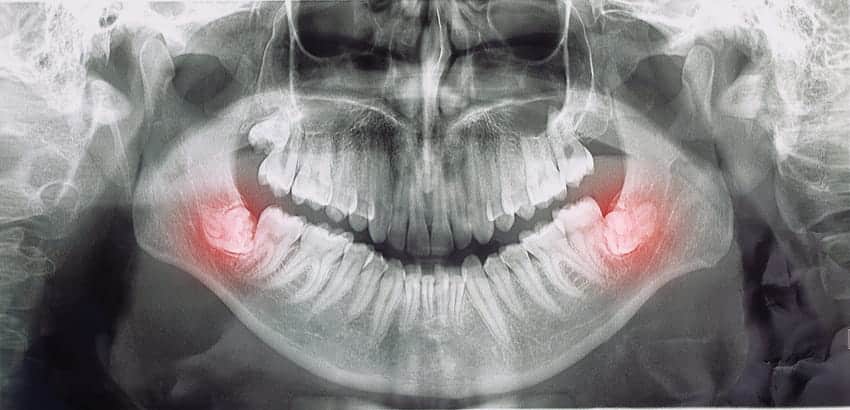
One of the most common types of oral surgery is a wisdom tooth extraction. Many people need to have these third molars removed because there is not enough room for them in the mouth. This can lead to impacted wisdom teeth, gum infections, overcrowding, tooth decay, and other dental issues.
If you’re having your wisdom teeth removed, it’s natural to feel a little anxious. However, the more you know about the wisdom teeth removal process, the better prepared you’ll be for the procedure and recovery time.
Schedule A Wisdom Teeth Consultation With A Trusted Dentist
If you’re experiencing pain in the back area of your mouth, it may be time to talk to a dentist about wisdom teeth removal. Schedule an appointment with your general dentist or find an experienced dental professional in your area for a consultation.
The dentist will take X-rays and perform a full exam to determine whether the wisdom teeth are growing and if they’re likely to cause problems. They may also recommend extraction if your child needs braces.
While some discomfort is normal when wisdom teeth grow, severe pain and swelling may be signs of a dental emergency. See a dentist who specializes in dental emergencies for immediate treatment, which may include an urgent extraction.
Wisdom Teeth Extraction: A Step-By-Step Guide
Depending on your situation, either a dentist or oral surgeon will perform your wisdom tooth extraction. Here’s what happens before and during the procedure.
1. Preparing For Your Appointment
Before the wisdom tooth extraction, your dentist or oral surgeon will explain what will happen and provide instructions on how to prepare. It’s essential you follow these directions to ensure everything goes smoothly. Your dentist may recommend the following:
- Refrain from eating or drinking for several hours before being sedated
- Do not smoke or use recreational drugs prior to the procedure
- If instructed, stop taking prescription medicines before your surgery
- Wear comfortable clothing and shoes that are easy to remove and put on
- Stock up on soft foods and other things you can eat during your recovery
- Arrange for transportation to and from the dental office
2. Sedation For The Procedure
There are different types of sedation available for patients having their wisdom teeth removed. Your dentist will decide which option is best based on these factors:
- Your current health status
- How many wisdom teeth are being removed
- The complexity of your procedure
- Allergies or sensitivities to sedatives
- The patient’s personal preference
The dentist may recommend local anesthesia or nitrous oxide (laughing gas) for simple extractions. However, general anesthesia may be more appropriate for complex extractions or if multiple wisdom teeth need to be removed.
3. Incision To The Gums
The dentist or oral surgeon will begin by making an incision in the gum tissue to expose the wisdom tooth. You will be sedated and not feel pain at this time. Depending on the position of the wisdom tooth, they may also need to remove bone blocking access to the tooth.
4. Removing The Tooth
To remove the wisdom tooth, the oral surgeon may divide the tooth into sections with special dental tools. Then, the tooth is gently loosened and pulled from its socket. This process is repeated for each wisdom tooth that needs removal. After the tooth is removed, the area is thoroughly cleaned to prevent infection.
5. Closing The Surgical Site
When necessary, your dentist will use stitches to close the incision. These are often dissolvable stitches that do not need to be removed later. Sterile gauze is placed over the surgical site to stop the bleeding and help the clotting process. At this point, you’re brought to a recovery area where the sedation will begin to wear off.
6. The Discharging Process
If you require anesthesia, you will need someone to pick you up and drive you home. Depending on the type of sedation you receive, you will not be able to operate a motor vehicle for several hours to days. Your dentist will discharge you to the designated person who will assist you after the procedure.
The Wisdom Teeth Removal Healing Process
You’ll be given details on the healing process after wisdom teeth removal. It’s likely you’ll feel sore for several days after surgery, so be sure to plan accordingly. The pain is often described as a throbbing ache that gradually subsides. However, pain medication easily alleviates most of the discomfort.
Some recovery tips your dentist may offer include:
- Use ice packs to reduce swelling and alleviate pain
- Take care to avoid the surgical site when you brush your teeth
- Only eat soft foods for several days as the incision heals
- Rinse your mouth often to remove food particles that become lodged in the socket
- Refrain from using a straw or anything else that could displace the blood clot
- Take prescription painkillers, antibiotics, and any other medications as directed
If you have concerns or experience any issues during your recovery time, such as excessive bleeding or worsening pain, contact your dentist right away. They may need to check your healing progress to assist with your recovery.


Regular Price:
$179
With this offer, there’s no excuse not to get back on track! Schedule a complete exam and x-rays for only $39 and ensure you have a beautiful healthy smile.
Wisdom Teeth Removal At Absolute Dental
Are you looking for wisdom teeth extractions in Las Vegas or Reno? Absolute Dental has several offices throughout the Las Vegas and Reno areas where you can get quality dental care at affordable rates. Contact us now to schedule an appointment!
Sources:
What to Know About Absorbable Sutures. (2023).
Wisdom Teeth Anesthesia Options. (2023).
Wisdom Tooth Removal. (2024).